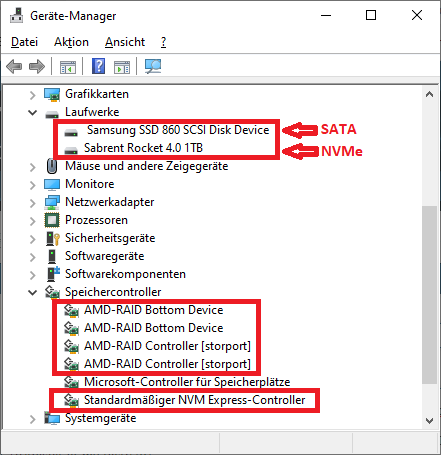(We have Gigabyte GA-X99-UD4 v1.0 FWIW)
The normal wisdom is: M.2 can’t be used for RAID so you must use AHCI. Why: because M.2 goes straight to CPU, not through PCH.
I thought I saw “somewhere” that Intel solved the bug… but haven’t found it again (yet).
What we want: BOOT from M.2 (either mobo connector or PCIe adapter), and have 2 HDD’s in RAID1… thus requiring RAID setting.
Is this possible? If not, can anyone explain the actual limitation (since I do NOT want RAID on M.2)?
Thanks heaps!
@MrPete :
Welcome to the Win-RAID Forum!
None of these statements is true.
1. Usually you can use an NVMe SSD and even can install the OS onto an NVMe SSD, no matter with which mode (AHCI or RAID) the on-board SATA Controller is running. The Intel RSTe NVMe drivers do support NVMe and SATA RAID simultaneously.
2. Not all on-board M.2 ports are directly connected to the CPU. I have tested it myself (look >here<).
Regards
Dieter (alias Fernando)
@MrPete :
Just to verify what I have written yesterday, I have today switched the SATA mode of my AMD X570 system to RAID mode.
System Drive C: 1 TB Sabrent Rocket 4.0 NVMe SSD
Storage Drive D: 1 TB Samsung 860 EVO SATA SSD (previously running in AHCI mode)
Result of my test:
After having switched the AMD SATA Controller from "AHCI" to "RAID" mode and installed the latest AMD RAID drivers, my X570 system is booting and running as smoothly as before.
My NVMe SSD is still bootable and I still have access to all my data, which were stored on the Samsung 860 SATA SSD while running the SSD in AHCI mode.
Here is the proof:

Hello MrPete
Let me clarify a little, M.2 is just the form factor and does not state what mode is used and how it is connected to the system. In the case of a X99 platform the M.2 slot can be directly connected to the CPU or it can be connected to the chipset (PCH). Further it can use the NVMe protocol (which uses PCI-E lanes) or it can use classic SATA protocol (AHCI or RAID) depending on the card/module inserted. These resources are sometimes shared with oder things on the mainboard, so if the slot is connected directly to the CPU it might share the lanes of another PCI-E slot or (usually seen on server/workstation boards) with an onboard U.2 connector. If you use a SATA protocol M.2 SSD the slot usually shares resources with onboard SATA connectors, so these get disabled when you put that kind of drive in there.
In your case (GigaByte GA-X99-UD4) the onboard M.2 slot is conneted to the chipset with (only) two PCI-E lanes and since the chipset only offers addidional PCI-E lanes in 2.0 these two are operated with that speed. So 2x PCI-E 2.0 (~ roughly 10GBit/s max.) - it even states that on the motherboard.
For a SATA based M.2 SSD like a Western Digital Green or Blue, Crucial MX300 or MX500, Samsung 860, Intel SSD 530/54x series in M.2 format or similar that port is totally fine.
If you use a NVMe (PCI-E) based SSD that port might be a bottleneck and you should use an adapter for a PCI-E slot -> M.2 with 4 lanes.
The next thing you mentioned, M.2 can also be used for RAID. Depending on what SSD you use and how the slot is connected to the system the ways can differ. As far as I know DOES Intel support RAID with SSDs directly connected to the CPU. I am not sure with the X99 platform since I don’t use RAID there, but on the server socket 2011-3 platform (C612 chipset which is identical to the X99) that is called VROC (Virtual Raid On CPU). But I think thats something for a different topic.
That’s totally possible and not even hard to accomplish.
Side note for your understanding, the X99 (C612) chipset supports 10 SATA ports. 6 usually just called SATA RAID/AHCI controller and another 4 called sSATA AHCI controller. Both can be operated independend, but only the first can be operated in RAID mode, also meaning that you can’t join drives from both controllers together in RAID so they have to be connected to either of these ports.
So depending on your SSD you have these possible options:
If the M.2 SSD is based on SATA, you can use the onboard M.2 slot.
As far as I know that shares the SATA ports 4&5 on your board, so these will be disabled.
Switch the SATA controller to RAID, connect your HDDs to SATA ports 0, 1, 2 or 3.
The M.2 SSD will also be controlled by that controller in RAID mode, but that should not affect its performance. The OS will need/use the Intel RST driver (included in Win 10).
If the M.2 SSD is based on NVMe you should use a PCI-E -> M.2 adapter.
Your GPU should sit in PCIE_1 (top slot) and the adapter should go inte the PCIE_3 slot (bottom one).
Switch the SATA controller to RAID, connect your HDDs to SATA ports 0-5.
The NVMe SSD will use it’s own driver (Win 10 included) or depending on the brand maybe it’s own (Samsung for example) and do not share anything with the Intel RST RAID controller and driver.
@Fernando
I think the statement MrPete made here was regarding to Intel and X99, so the AMD solution and example you brought might not be relevant althought similarities may exist.